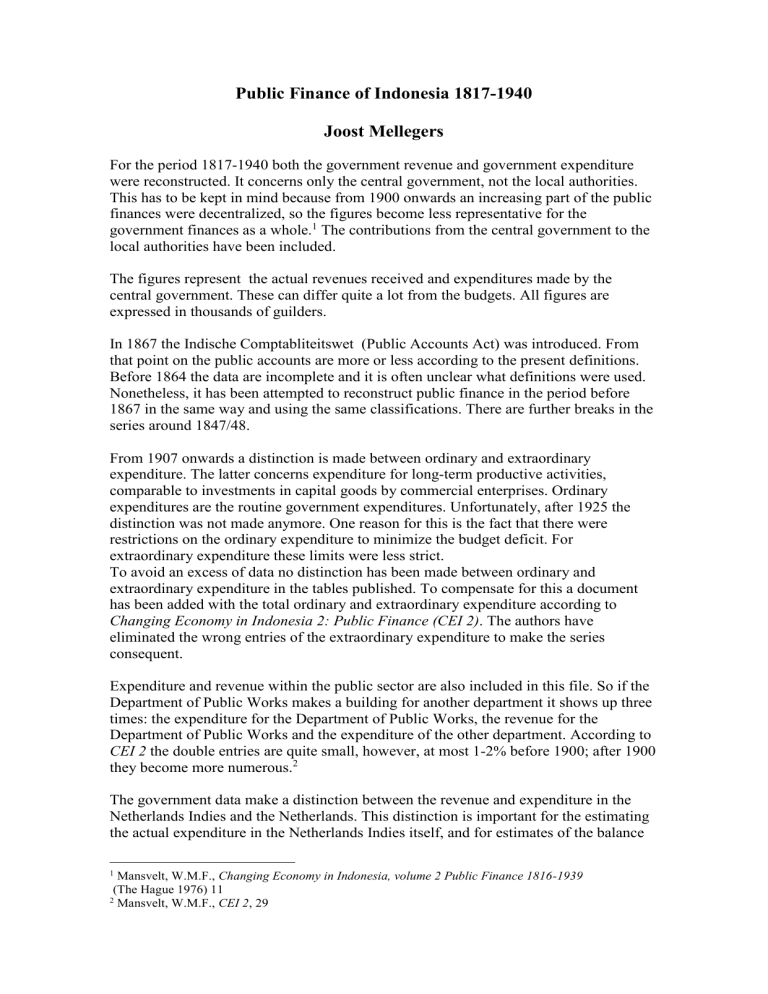
Public Finance of Indonesia 1817-1940
Joost Mellegers
For the period 1817-1940 both the government revenue and government expenditure
were reconstructed. It concerns only the central government, not the local authorities.
This has to be kept in mind because from 1900 onwards an increasing part of the public
finances were decentralized, so the figures become less representative for the
government finances as a whole.1 The contributions from the central government to the
local authorities have been included.
The figures represent the actual revenues received and expenditures made by the
central government. These can differ quite a lot from the budgets. All figures are
expressed in thousands of guilders.
In 1867 the Indische Comptabliteitswet (Public Accounts Act) was introduced. From
that point on the public accounts are more or less according to the present definitions.
Before 1864 the data are incomplete and it is often unclear what definitions were used.
Nonetheless, it has been attempted to reconstruct public finance in the period before
1867 in the same way and using the same classifications. There are further breaks in the
series around 1847/48.
From 1907 onwards a distinction is made between ordinary and extraordinary
expenditure. The latter concerns expenditure for long-term productive activities,
comparable to investments in capital goods by commercial enterprises. Ordinary
expenditures are the routine government expenditures. Unfortunately, after 1925 the
distinction was not made anymore. One reason for this is the fact that there were
restrictions on the ordinary expenditure to minimize the budget deficit. For
extraordinary expenditure these limits were less strict.
To avoid an excess of data no distinction has been made between ordinary and
extraordinary expenditure in the tables published. To compensate for this a document
has been added with the total ordinary and extraordinary expenditure according to
Changing Economy in Indonesia 2: Public Finance (CEI 2). The authors have
eliminated the wrong entries of the extraordinary expenditure to make the series
consequent.
Expenditure and revenue within the public sector are also included in this file. So if the
Department of Public Works makes a building for another department it shows up three
times: the expenditure for the Department of Public Works, the revenue for the
Department of Public Works and the expenditure of the other department. According to
CEI 2 the double entries are quite small, however, at most 1-2% before 1900; after 1900
they become more numerous.2
The government data make a distinction between the revenue and expenditure in the
Netherlands Indies and the Netherlands. This distinction is important for the estimating
the actual expenditure in the Netherlands Indies itself, and for estimates of the balance
1
Mansvelt, W.M.F., Changing Economy in Indonesia, volume 2 Public Finance 1816-1939
(The Hague 1976) 11
2
Mansvelt, W.M.F., CEI 2, 29
of payments. Unfortunately the data for expenditures in The Netherlands are very
incomplete.
From 1930 on the ‘Indische Bedrijvenwet’ was applied to an increasing number of
government companies. The most important consequences were: 1. Only the balances of
the public companies show up in the public finance, not the expenditure and revenue; 2.
The companies are charged for the loans they receive.
Bibliography
Archivalia and manuscripts
Bosch, J. van den, Collectie J. van den Bosch (Collection J. van den Bosch) archive No.
343 National Archief (General State Archives), The Hague
Printed sources
Begroting van Nederlandsch-Indië (Netherlands Indian Budget). Appendix to the
Handelingen van de Tweede Kamer der Staten Generaal (Proceedings of the Second
Chamber of the States General); from 1918 on: Handelingen van den Volksraad
(Proceedings of the People’s Council). These are not only estimates but also outcomes
for public finance. Very detailed, mostly used when the other sources were not
sufficient.
Bussche, C. van den, Het verloop van ’s Lands financiën in de laatste jaren en de
verwachting daaromtrent voor de naaste toekomst (Recent Developments of Public
Finance and Prognoses for the Nearest Future) (Jakarta, 1924)
Kielstra, E.B., De financiën van Nederlandsch-Indië (Public Finance in Netherlands
India) (The Hague 1904)
Mansvelt, W.M.F., Changing Economy in Indonesia, volume 2 Public Finance 18161939 (The Hague 1976)
The official reporting by the government changed a couple of times in name and format.
Below a list of the different titles of the reports, the years they were published and
information about the years the different reports are used as a source for reconstructing
the public finances.
Koloniale Overzichten (Colonial surveys) in the Staatkundig en Staathuishoudkundig
Jaarboekje 1849-1884
Statistisch Overzicht van Nederlandsch-Oost-Indië in Bijdragen van de Vereniging voor
de Statistiek
Koloniaal Verslag (Colonial Report). Appendix to the Handelingen van de Tweede
Kamer der Staten Generaal (Proceedings of the Second Chamber of the States
General). these were used mainly for the period 1846-1866
Koloniaal Verslag (Colonial Report; with two parts) 1891-1896
Jaarcijfers Koloniën (Annual Figures Colonies)
Jaarcijfers voor het Koninkrijk der Nederlanden. Koloniën (Annual Statistical Abstracts
for the Kingdom of The Netherlands. Colonies.)
This was used for the years 1871, 1876, 1881, 1886-1921,
Statistisch Jaaroverzicht Nederlandsch-Indië (Statistical Abstract for the Netherlands
East-Indies), the main source for the period 1924-1940
Tien Begrotingen met den Volksraad 1919-1928 (Netherlands Indian Estimates during
the first Decade of the People’s Council 1919-1928) (Jakarta 1928)
Het tweede tiental begrotingen met den Volksraad (1929-1938) (Netherlands Indian
Estmates during the second Decade of the People’s Council 1929-1938)
Money, J.W.B., Java, or how to manage a Colony (London 1861 and Reproduction
with an introduction by Ian Brown Singapore [etc.] 1985), Also published in Dutch:
Java, of hoe eene kolonie bestuurd moet worden (translated with annotations by D.C.
Steyn Parvé; Zutphen 1861)
Overzicht der Geldmiddelen van Nederlandsch-Indië van 1867 af. (Survey of Finances
for the Netherlands East-Indies from 1867 on.) Published by the
Department of Colonies. (The Hague 1916)












